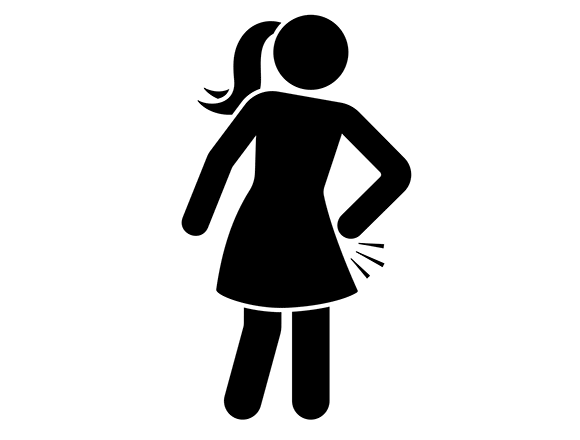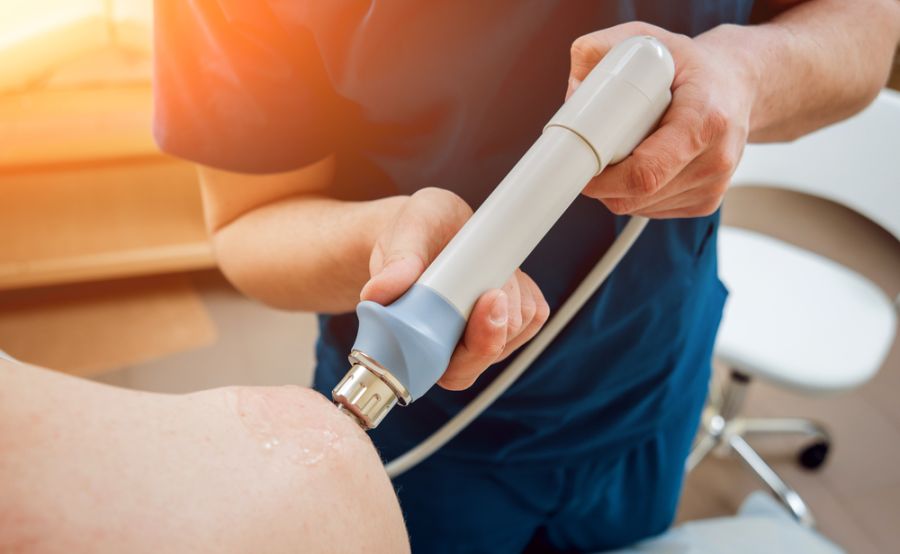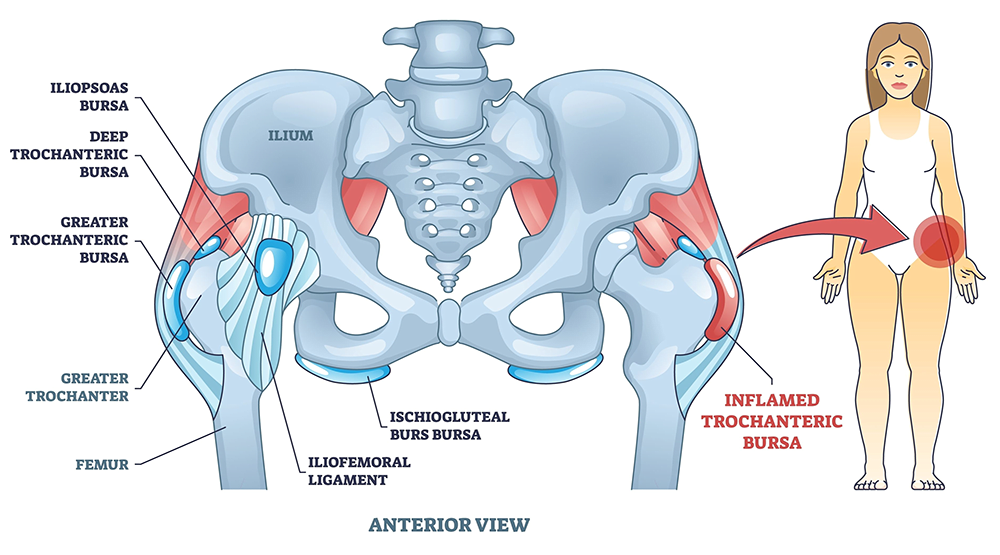Trochanteric pain syndrome, also known as hip bursitis, is a painful condition that can significantly impact the quality of life if left untreated. Extracorporeal shock wave therapy (ESWT) is clinically proven to be an effective and non-invasive treatment for the condition. Let's take a closer look at the problem of hip bursitis and how ESWT can help.
What is trochanteric pain syndrome/hip bursitis?
What is trochanteric pain syndrome/hip bursitis?
Bursae are tiny sacs that are filled with a jelly-like fluid. They're located between soft tissues and bones and can be found all over the body. They act like cushions to prevent friction as bones and soft tissues move against each other. Sometimes bursae can become inflamed due to injury or other problems, which causes the pain and discomfort associated with bursitis. Hip bursitis is the inflammation of the greater trochanteric bursa, located outside the hip bone at the top of the femur.
Hip bursitis is often described as trochanteric pain syndrome because it appears more than just the bursa is involved in the condition. Tendons surrounding the trochanteric bursa seem to experience inflammation and irritation, contributing to pain radiating out towards the buttock region and down the thigh.

What are the symptoms of trochanteric pain syndrome?
What are the symptoms of trochanteric pain syndrome?
The main symptom of hip bursitis is a pain in the hip joint that often extends down the outer thigh. Early stages of the condition usually cause sharp, intense pain, which develops into a more profound ache across the entire hip area as the problem grows.
Most people find that the pain worsens after prolonged activity or inactivity periods. For example, it's common for hip bursitis pain to be more intense at night, mainly when sleeping on the side of the affected hip or when getting up after being sat for a long period of time. Squatting and walking upstairs can also trigger a worsening of the pain.

What causes trochanteric pain syndrome/hip bursitis?
What causes trochanteric pain syndrome/hip bursitis?
Hip bursitis can affect anyone, but it most commonly affects middle-aged women and elderly people. There are many reasons why the condition may come about. In some cases, it is caused by repetitive hip overuse from walking, running, climbing stairs or cycling. In other cases, acute injury triggers the problem, such as falling on or bumping the hip.
People with an uneven stride caused by issues like spine disease or leg-length inequality are more susceptible to bursitis. The problem can also arise due to irritation caused by bone spurs or calcium deposits that develop in the trochanter's tendons. Rheumatoid arthritis, which causes the lining of joints to swell, can cause inflammation of the bursa and lead to trochanteric pain syndrome.

What treatments are available for hip bursitis?
What treatments are available for hip bursitis?
Many people with hip bursitis manage the condition by modifying their activity to prevent flare-ups and using crutches and painkillers to get around and alleviate pain. Physical therapy can help to improve the situation by gradually increasing the strength and flexibility of the muscles and tendons surrounding the hip. However, it can take months until physical therapy has a positive effect.
Sometimes steroid injections are given in the hip to alleviate pain temporarily for a few months at a time, but prolonged use of steroid injections can lead to tissue damage, so this is not an ideal solution. In extreme cases, surgery is performed to remove the affected bursa, but this invasive procedure requires a general anaesthetic. Extracorporeal shock wave therapy (ESWT) is an excellent alternative to steroid injections or surgery for hip bursitis because it is a non-invasive method for alleviating pain.

What is extracorporeal shock wave therapy?
What is extracorporeal shock wave therapy?
ESWT, often simply referred to as shock wave therapy has been used in medicine for more than 25 years. It was initially used as a therapy for kidney stones since it works to break up the stones into small enough fragments that they can pass via urination. Since then, its orthopaedic benefits have been studied extensively, and the therapy is now used to improve various conditions affecting bones and soft tissues.
Shock wave therapy delivers energy impulses to the treated area to increase blood flow. Our blood carries oxygen and other nutrients to cells throughout the body to keep them healthy. Bosting blood flow in an injured area can stimulate or heighten the body's natural healing processes. The energy impulses also help break up tendon calcification, an issue that often inhibits blood flow, and relieve knots and scar tissues in muscles to alleviate tightness. Since trochanteric pain syndrome is linked to tendons and muscles in addition to bursae, shock wave therapy is therefore an excellent treatment.

Which type of ESWT is better for hip bursitis?
Which type of ESWT is better for hip bursitis?
There are two types of ESWT - radial and focused. Radial shock wave therapy applies impulses across a wide local area of the body. It offers a relatively superficial depth of treatment, reaching 3cm to 4cm deep. It is most helpful in treating issues affecting a large body area at a relatively superficial level. Focused shock wave therapy applies impulses across a small body area and at a flexible depth that can reach up to 12cm. Its precise application of energy is ideal for acute injuries and targeting tissues close to bones.
Given its ability to penetrate deep tissues, focused shock wave therapy is the better choice for helping trochanteric pain syndrome because it can reach the tissues surrounding the hip. Focused shock wave therapy technology manufactured by BTL is selective, which means it only produces discomfort when the impulses hit scar tissue, injured tendon tissue or calcification. This makes treatment significantly more comfortable than radial shock wave therapy.
Is extracorporeal shock wave therapy clinically proven for trochanteric pain syndrome?
Much clinical evidence demonstrates that ESWT can offer effective relief from pain caused by trochanteric pain syndrome. In 2016 a study into the effects of ESWT in patients with chronic trochanteric pain syndrome found that a combination of shock wave therapy and a rehabilitation programme proved successful in decreasing pain, with sleep quality and depressive symptoms also improving thanks to relief from pain. The study found that 63% of patients were satisfied or very satisfied with the treatment three months after.
In 2018 another study backed up these findings by establishing via MRI that radial ESWT can be an effective pain relief treatment for trochanteric pain syndrome. It found an immediate success rate of 83.3% and a long-term success rate of 55.6%. Focused shock wave therapy appears to be even more successful. A multicenter, randomised and controlled clinical trial conducted in 2020 found that focused ESWT performed alongside exercise safely provided relief from trochanteric pain syndrome with an 86.8% success rate two months after treatment with results maintained for at least six months.
How long does shock wave therapy for hip bursitis take?
How long does shock wave therapy for hip bursitis take?
Shock wave therapy requires multiple treatment sessions to achieve optimum results. Three to five sessions performed at weekly intervals are usually recommended. The number of sessions needed varies depending on the severity of your pain and how far the condition has progressed. Shock wave therapy tends to offer relief from pain more quickly than physical therapy.
The studies above demonstrate that exercise and shock wave therapy offers successful treatment. It is therefore recommended to embark on a gentle workout or physical therapy regime to strengthen the tendons and muscles in the hip and improve flexibility. Shock wave therapy aids the healing of the hip while exercise rehabilitates the tendons and muscles.
What should I expect when I undergo shock wave therapy?
What should I expect when I undergo shock wave therapy?
Here at London Shock Wave & Sports Injury Clinic, we'll begin your treatment with an examination. We'll conduct a physical exam of your hip and a series of orthopaedic tests to assess the current state of your condition. We'll also examine your medical history. If you've already been diagnosed with hip bursitis or trochanteric pain syndrome, we'll ask to see existing imagery of your injuries, such as MRI, CT scans, X-Ray or ultrasound. Otherwise, we may request new imagery be taken to allow us to accurately determine a diagnosis and treatment plan.
Once we have a sound understanding of the problem, we begin shock wave therapy. A series of treatment sessions are necessary, and we recommend rehabilitation alongside shock wave therapy. We then assess the progress of your recovery period to determine success and make adjustments to your treatment plan where necessary.

Request a call back to learn more
If you're coping with painful hip bursitis and think shock wave therapy could help, we'd love to help. Request a call back now to find out if this effective treatment could be suitable for you.
